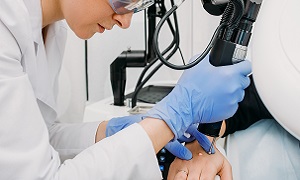Skin Cancer
Skin cancer is the abnormal growth of skin cells that develops on the exposed skin. These areas are the face, arms, chest and hands. However, this can also affect the areas of skin that get less exposure to the sun’s rays. These areas are lips, scalp, neck, the bottom of the feet, ears, genitals and under your fingernails or toenails. Skin cancer starts to appear as freckles, moles or spots on skin.
Types of Skin Cancer
The various types of skin cancer are as under:
- Melanoma – It is the most serious skin cancer. It develops in the melanin-producing cells called melanocytes. Melanin is a pigment responsible for giving color to your skin. This type of cancer mostly occurs in the eyes and sometimes in other body parts like throat or nose.
- Non-melanoma skin cancer – It refers to all the types of skin cancer that are non-melanotic. The treatment of this cancer depends on the type of cancer, whether basal cell carcinoma or squamous cell carcinoma. These two types of cancer fall under the broader category of non-melanoma skin cancer.
- Basal cell carcinoma – It is another type of skin cancer that begins in the basal cells. Basal cells are the type of cells present in the skin that produce new skin cells when the old cells die. This type of cancer appears as a transparent bump on the skin. However, it may take other forms. It occurs in the areas with the greatest exposure to the sun’s rays like head and neck.
- Squamous cell carcinoma of the skin – Squamous cell carcinoma is a more common type of skin cancer. It develops in the squamous cells responsible for making the middle and outer layers of the skin. The cancer is of an aggressive nature but is not life-threatening. If left untreated, cancer may spread to other parts of the body and grow in size causing serious complications.
Causes of Skin Cancer
When mutations or errors occur in the DNA of the skin cells, then it may cause skin cancer. The cells grow out of control due to these mutations and they form a mass. There are myriad types of cells involved in skin cancer. The top layer of the skin is the epidermis. The epidermis is a thin layer providing a protective coat of skin cells that continuously shed from your body. It has three types of cells in it.
- Squamous cells- They are present immediately below the outer surface. They act as the inner lining of the skin.
- Basal cells- They lie below the squamous cells. They produce new skin cells.
- Melanocytes- These cells produce melanin, which is a pigment that provides normal color to the skin. The cells are present in the lower part of the epidermis. Melanocytes protect the deeper layers of skin by producing more melanin when your body experiences more exposure to the sun’s rays.
Other causes
UV (ultraviolet) radiation found in sunlight and light used in tanning beds causes much damage to the DNA in the skin cells. There are other factors too, that contribute to the risk of skin cancer. These factors may be conditions that weaken the immune system or exposure to toxic substances.
Symptoms of Skin Cancer
Origin of cancer – Cancer occurs in the areas of skin with sun exposure like the scalp, ears, chest, face, neck, lips, hands & arms. It may also occur on the legs in women. Sometimes, it occurs on palms, under your toenails or fingernails and in the genital region.
Symptoms of Basal Cell Carcinoma – It mostly occurs on the neck or face of your body. Cancer appears as a waxy or pearly bump. It may also appear as a brown scar-like or flesh-colored lesion or as a scabbing or bleeding sore that returns on healing.
Symptoms of Squamous Cell Carcinoma – It appears on ears, face and hands. People with dark skin are at a greater risk of developing squamous cell carcinoma. It looks like a red, firm nodule. It may appear as a flat lesion with a crusted, scaly surface.
Symptoms of Melanoma – Melanoma may develop on an existing mole of your body that becomes cancerous or on the normal skin. It occurs on the face or even on the trunk of the affected men. Melanoma usually develop on the lower legs in women. Melanoma affects the area of the skin with minimum exposure to the sun in both men and women. It appears on the palms and soles of the people with dark skin tones. The signs of melanoma are:
- A mole that bleeds or changes in size, color and feel.
- A painful lesion that burns or is itchy.
- A large brownish spot with dark freckles.
- Dark lesions on the fingertips or toes, palms, soles, the lining of mouth, nose, anus or vagina.
- A lesion that appears red, white, pink, blue or blue-black with an irregular border.
Diagnosis of Skin Cancer
Skin Examination
Skin Biopsy
Treatment options for Skin Cancer
The treatment options for precancerous skin lesions and skin cancer vary. It depends on the type, size, location and depth of the lesions.
Freezing

Excisional surgery
Radiation Treatment

Radiation treatment uses X-rays to kill the cancerous cells.
Chemo
Immuno/Biological Treatment
This treatment requires the use of the immune system of the body to kill the cancer cells completely.




